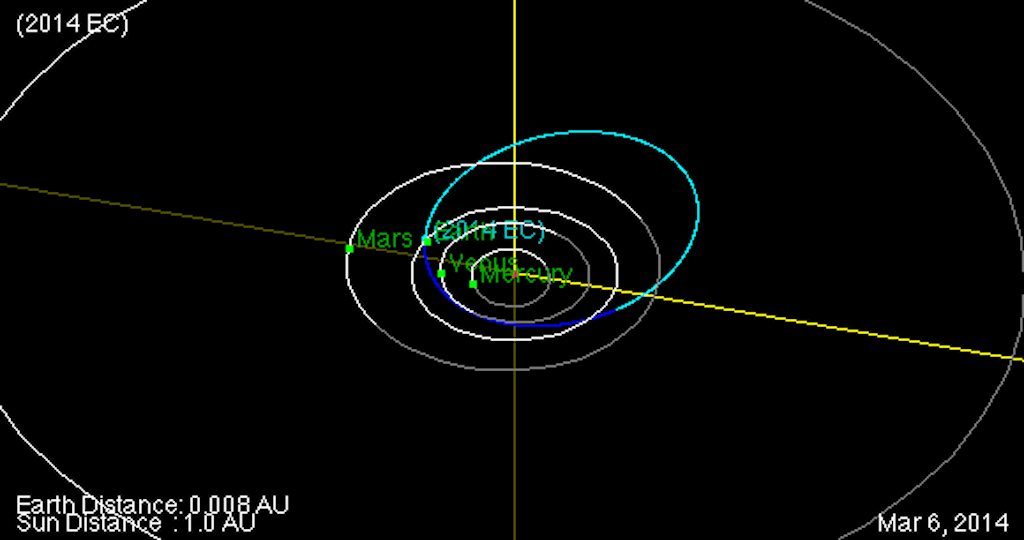
Editor's update (for 9 p.m. ET): Asteroid 2014 EC has zipped by Earth during its super-close flyby on Thursday (March 6). It was actually the third close flyby of an asteroid inside the orbit of the moon in the last two days, according to NASA. See our full story: Small Asteroid Gives Earth a Close Shave, 3rd in 2 Days
For the second day in a row, a space rock is going to zip close by Earth within the orbit of the moon, and you can watch the encounter live online.
The 33-foot-wide (10 meters) near-Earth asteroid 2014 EC will come within 38,000 miles (62,000 kilometers) of Earth's surface at 4:30 p.m. ET (2130 GMT) Thursday (March 6), NASA officials said. That's just 16 percent of the distance between our planet and the moon, which is about 239,000 miles (385,000 km) on average. You can see a video of asteroid 2014 EC's orbit arount the sun here.
The online Virtual Telescope Project will attempt to capture the space rock's flyby live. You can watch the webcast of asteroid 2014 EC live on Space.com beginning at 2:00 p.m. EST (1900 GMT), courtesy of the Virtual Telescope Project. Or you can go directly to the project's website: http://www.virtualtelescope.eu/webtv/

2014 EC, which was discovered just Tuesday (March 4), is about half as wide as the asteroid that exploded over Russia in February 2013, injuring about 1,500 people. There is no danger that 2014 EC will hit Earth on this pass, researchers stress; the chances that it will ever strike the planet are currently estimated at 1 in 2.7 million.
While 2014 EC will come extremely close to Earth, it's not a great skywatching target. The asteroid won't be visible through binoculars or small telescopes, said Don Yeomans, manager of NASA's Near-Earth Object program office at the Jet Propulsion Laboratory in Pasadena, Calif.
"Moderately sized telescopes if you know where to look — yes," Yeomans told Space.com via email. "The asteroid will reach an apparent magnitude of about 13.6 near closest approach."
Get the Space.com Newsletter
Breaking space news, the latest updates on rocket launches, skywatching events and more!
The flyby of 2014 EC follows closely on the heels of another space rock encounter. On Wednesday (March 6), the 100-foot-wide (30 m) asteroid 2014 DX110 zoomed by Earth, passing inside the orbit of the moon at a range of 217,000 miles (350,000 km).
Such back-to-back flybys are pretty special, though they can't exactly be called rare events, Yeomans said.
"For small asteroids, one would expect a flyby of the Earth, to within the moon's distance, about every two weeks," he said.
Astronomers think that more than 1 million asteroids cruise through space in Earth's neighborhood. To date, just 10,600 have been discovered and named.
Follow Mike Wall on Twitter @michaeldwall and Google+. Follow us @Spacedotcom, Facebook or Google+. Originally published on Space.com.
Join our Space Forums to keep talking space on the latest missions, night sky and more! And if you have a news tip, correction or comment, let us know at: community@space.com.

Michael Wall is a Senior Space Writer with Space.com and joined the team in 2010. He primarily covers exoplanets, spaceflight and military space, but has been known to dabble in the space art beat. His book about the search for alien life, "Out There," was published on Nov. 13, 2018. Before becoming a science writer, Michael worked as a herpetologist and wildlife biologist. He has a Ph.D. in evolutionary biology from the University of Sydney, Australia, a bachelor's degree from the University of Arizona, and a graduate certificate in science writing from the University of California, Santa Cruz. To find out what his latest project is, you can follow Michael on Twitter.









